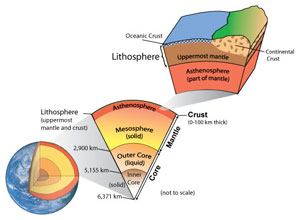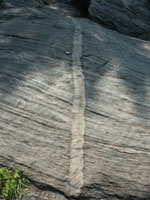Earth formed about 4.6 billion years ago during the birth of our solar system. This date comes from meteorites and moon rocks. For several hundred million years after the formation of the solar system the planets were continuously bombarded by meteoric debris thus the surface of the Earth probably remelted repeatedly by the impacts of large asteroids. This early bombardment continued until about 3.8 billion years ago.
During the next major phase of earth’s formation cooling and differentiation of the Earth’s layers occurred. Dense materials sank to the center, forming an iron-nickel rich core. Lighter buoyant silicate-rich magma rose to the surface. The remaining material between the core and the magma formed Earth’s thickest layer, called the mantle,which is composed mainly of iron, magnesium, calcium-rich silicate minerals (Figure 1).

Figure 1: Cross sectional view of Earth illustrating its heterogeneous layers. (image from Beatty, J. K. and A. Chaikin, eds. The New Solar System. Massachusetts: Sky Publishing, 3rd Edition, 1990.)
Click to enlarge.
Eventually, the magma cooled to form a thin layer of silica/aluminum-rich crust . Oceanic crust is composed of dense basalt and gabbro. Continental crust is less dense and has a granitic composition overall.
The division of the Earth’s interior into 3 distinct layers called the core, mantle, and crust is based on chemical composition. Earth’s interior is commonly further differentiated into 5 layers based on physical properties (Figure 2). Starting from the Earth’s surface, the interior is divided into the lithosphere, asthenosphere, mesosphere, outer core, and inner core. .
The Rock Cycle
The rock cycle is a fundamental concept describing dynamic transitions of minerals and materials through three main rock types: sedimentary, metamorphic, and igneous.
Igneous rock forms from the crystallization of molten material (magma) from the lithosphere. Igneous rock may be classified as intrusive if the magma cools and solidifies underground. When magma reaches Earth’s surface through a volcanic eruption, the resulting rock is known as extrusive igneous rock.
Once exposed to atmospheric conditions at the surface of the earth, weathering processes cause rocks to disintegrate or decompose into loose sediment and dissolved ions. Sediment can be transported by rivers, wave action, wind, gravity, or glacial ice, be deposited, and become buried whereby the loose grains may be compacted and cemented (lithified) and converted into clastic sedimentary rock. Chemical sedimentary rock is deposited by chemical precipitation of minerals held in solution. Sedimentary rock may also be classified as organic such as coal that forms from the compaction of plant material.
If buried deep enough, rock can be subjected to high temperature intense pressure causing it to change into the third rock group called metamorphic rock. If metamorphic rock undergoes additional heating or still higher pressure it may completely melt and once again become magma, completing the rock cycle.
As illustrated in the diagram to the right, other pathways exist in the rock cycle. Over the course of Earth’s long history rocks have been formed, changed, and reformed again and again.
Geologic Time
There are two types of geologic age determinations: relative age and numerical age. Geologists in the late 18th and early 19th century studied rock layers and the fossils in them to determine relative age. It wasn't until well into the 20th century that enough information had accumulated about the rate of radioactive decay that the age of rocks and fossils in number of years could be determined through radiometric age dating.
Relative age dating means to place events in a proper sequence or order, without knowing the age in years. Deciphering a sequence of geologic events is done by applying four fundamental principles:
1) Law of Original Horizontality: Sedimentary rock layers, and large lava flows, are initially deposited in a horizontal or nearly horizontal orientation due to gravity (Figure 4). Therefore if rock layers appear tilted to the horizon we can assume the rocks have been moved into that position by some crustal disturbance sometime after their deposition (Figure 5).
2) Law of Superposition: In an undisturbed sequence of sediments and lava flows, the layer above is younger than the layer below (Figure 4).
3) Law of Lateral Continuity: Sediments and lava flows are generally laterally continuous; if not then they are usually cut by faults. Original sedimentary layers extend to the edges of a depositional environment (such as a lake or ocean basin) until they thin or taper off or until one type of sediment laterally interfingers with another as the depositional environments change.
|
4) Law of Cross-Cutting Relationships: |
Figure 6: A light colored igneous dike cutting across (slightly darker colored)
metamorphic rock layers in New York City’s Central Park, thus making the dike younger than the rock
it cuts through. Click to enlarge.
|
Using basic geologic principles such as the four described above, as well as the presence of distinctive fossils found in sedimentary rock layers, geologists have devised a standard geologic time scale. This is a worldwide relative time scale that can be used to correlate rocks even on different continents (Table 1).
| Eon | Era | Period | Epoch | |
|---|---|---|---|---|
| Phanerozoic | Cenozoic | Quaternary | Holocene | |
| Pleistocene | ||||
| Tertiary | Pliocene | |||
| Miocene | ||||
| Oligocene | ||||
| Eocene | ||||
| Paleocene | ||||
| Mesozoic | Cretaceous | |||
| Jurassic | ||||
| Triassic | ||||
| Paleozoic | Permian | |||
| * Carboniferous | Pennsylvanian | |||
| Mississippian | ||||
| Devonian | ||||
| Silurian | ||||
| Ordovician | ||||
| Cambrian | ||||
| Proterozoic | Precambrian (informal name) |
Vendian (or Ediacaran) | ||
| Archean | ||||
| Hadean | ||||
*Outside of North America, the Pennsylvanian and Mississippian Periods are known as the Carboniferous Period.





